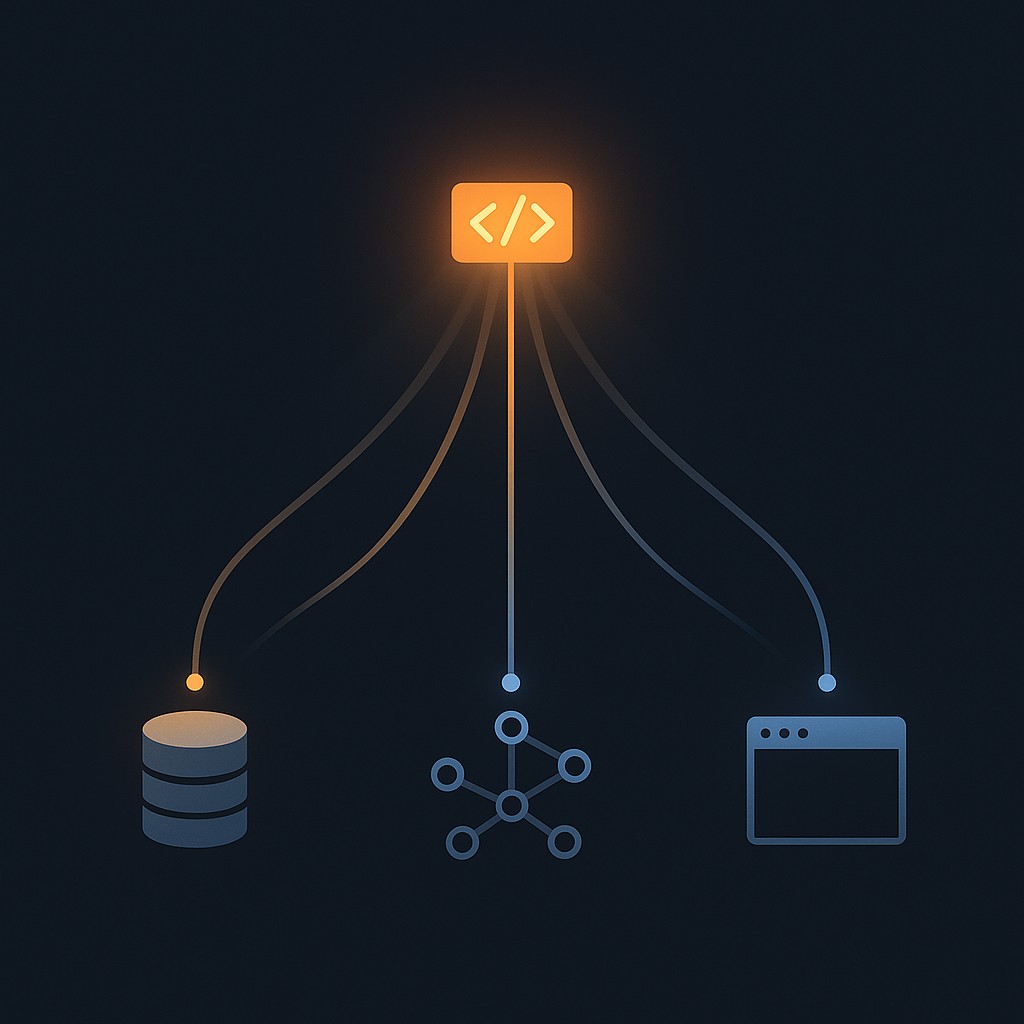Scale Developer Impact with AI: Operate at Higher Abstractions
Scale Developer Impact with AI: Operate at Higher Abstractions

The 1,000x Leap: How One Modern Line of Code Changed Everything
It hit me the other day staring at a line I’d written—a simple query, wrapped in layers of frameworks, instantly pulling data from a database, running an analysis, and popping up a visualization in the browser. I thought about how far we’ve come. Back in the early computing days, one line meant toggling a hardware circuit, maybe lighting up an LED if you were lucky. Now, a single line can orchestrate a symphony of systems. That jump isn’t just a neat technical trick. It’s the core reason we’re standing in a completely different field than the folks who wrote code on punch cards.

A modern line of code does more—it helps you scale developer impact with AI. It’s not just about the syntax or the language. It’s what each “one line” can signal about our capability. When you write code today, you’re leveraging entire worlds at once.
Once, coding meant punching cards and waiting hours—or days—for feedback. You’d hand your stack to an operator, hope it didn’t jam, and cross your fingers the output matched expectations after a long wait. These days, it’s minutes from idea to result, thanks to tooling and automation. When frameworks and abstractions do the work, feedback loops tighten, and discovery gets faster.
Back then, code ran on a single machine. Your terminal, maybe a mainframe. Today, one line can scale engineering impact globally in the cloud, serving millions. Scaling isn’t just hype. Concurrent requests are driven by RequestsPerSecond times AvgDurationInSeconds, making the modern leap to global throughput easy to quantify. That’s not theoretical reach. It’s real-time impact, and the numbers are right there.
I get why the headlines and complexity trigger nerves. “AI is coming for your job.” But not how you think. There’s anxiety, for sure, but also an opening. We’re standing on top of these massive layers now, and each one multiplies what one engineer can do—not replaces it. If you feel the stakes rising, you’re just paying attention. The next step is figuring out how to use it.
Multiplying Your Impact: Scale Developer Impact with AI Through Higher Abstractions
Let’s put some actual numbers behind all this talk. Think about your work in terms of capability times speed times reach—the breadth of tasks you can handle, how fast you get feedback, and how many users you ultimately serve. The multiplier gets wild fast. Imagine: 1,000x the tasks, 100x the speed, 1,000x the reach. Multiply those together and you get a 100,000,000x engineer. Spoiler. Here’s why you might already be a 100,000,000x engineer—because small improvements at each level compound into something enormous before you even notice.
Impact multiplies when you operate at higher abstractions. Early compilers took hand-assembled machine code and made it repeatable, readable, flexible. Libraries let you skip reinventing the wheel; frameworks and good IDEs turn a single line of intent into a cascade of operations you never have to see. The cloud then took it global—one deploy and you’re everywhere at once.
Now, AI is sliding into that stack as the next abstraction layer. It’s not here to replace engineers. It’s the next abstraction layer orchestrating intent across tools, turning a pile of commands into outcomes faster than before. AI can now classify, edit, summarize, answer questions, and draft new content all within one layer, so the leap is not just speed, but scope. What you can actually get done expands dramatically.
A year ago I wouldn’t have imagined relying on AI-generated scaffolding for real projects. I used to think every detail needed a personal touch. Lately though, the creeping complexity is real. When things get confusing, it’s easy to slide back to what’s comfortable—to low-level details, hand-coded bits, little routines you know by heart. I do it too when I hit decision fatigue. But there’s a better way. Flipping the lens to outcome-first thinking shifts focus from how it works under the hood to what high-leverage results you can deliver—and that changes everything.
Look at what tools like GitHub Copilot are already doing in practice. Work that used to eat up hours—writing boilerplate, catching typos, hunting down half-remembered APIs—is squashed into minutes. The feedback loop isn’t just tighter. It’s continuous. You write, you see, you tweak, almost in real-time. That acceleration means you actually ship faster and learn quicker. The cycle used to be one commit per day; now it’s dozens. Now, that’s developer leverage with AI you can feel.
There’s one thing I haven’t figured out. Every time I automate a big chunk of my process, I save hours—but sometimes I end up spending half of those hours fixing tiny issues AI introduced that I’d never have written myself. The net result is still a win, but I haven’t nailed the balance yet.
Your First AI Amplification: A Concrete Week-Long Plan
Start here: make one intentional commitment this week. Pick a single AI-powered abstraction and put it to work in your actual workflow. Don’t just read about it. Choose a spot where you’re repeating yourself and let the tool actually handle it. Not next month, by Friday.
What are you looking for? Zero in on the bits that keep cropping up—those pieces you copy, paste, and tweak, like boilerplate scaffolding, test harnesses, or churning through trivial schema migrations. The trick is outcome focused engineering—shift from “how much code did I write?” to “did the outcome get delivered with less friction?” Define what finished looks like—whether that means all new routes spun up, linting passes green, or tedious test cases filled out.
Here’s one concrete pattern: say you’re always drafting unit tests but only the odd logic branch is interesting. Use an AI tool to sketch the common test scenarios or auto-generate CRUD endpoints using your favorite framework. Then put your time into the real edge cases, architectural clarity, or documentation. Watch how quickly you can get to feedback and how many distinct kinds of small tasks are handled for you. You’ll be multiplying the number of problems crossed off your list by orders of magnitude.
Funny how some lessons show up outside of code. Not long ago I spent a Saturday afternoon wrestling with a new espresso machine. Instead of following the instructions, I tried to hack it apart and “optimize” the process—ended up with coffee grounds everywhere and something that tasted suspiciously metallic. Eventually, I just went back, used the machine as intended, and fixed the problem in five minutes. Sometimes, the fancy manual tweaks are just time sinks. The abstraction, when you trust it, moves you forward.
Remember where this started—a single modern line, through frameworks, can already query a database, crunch data, and spit back a plot. AI’s sweet spot right now is connecting those dots even faster, filling in gaps and automating the glue between steps so you can leap from question to insight with fewer manual hops.
To genuinely see if it’s working, track three straight measures this week—capability (how many kinds of tasks you offloaded), speed (how fast you got working results; just time from idea to feedback), and reach (how many users or endpoints got covered). Tally it Friday and check the trends. The improvement isn’t subtle.
Put outcome-first thinking to work—use our app to draft, edit, and publish AI-powered content in minutes, so you can test ideas faster, tighten feedback loops, and see real impact without getting stuck in boilerplate.
Guardrails & Perspective: Making AI Adoption Safe (Without Losing What Matters)
If you’re nervous about spending too much time setting up new AI tools, here’s the trick. Treat your first experiment like a code spike in your usual IDE. Give yourself a simple, bounded task and just thirty or sixty minutes to play. The key is to set up guardrails and prompts, not build a production system from scratch.
Worried about reliability? Keep your tests, static checks, and reviews right where they’ve always been. To leverage AI in engineering, think of it not as a replacement but as a drafting partner. The outputs get a lot more dependable once you enforce that separation. Let the tool propose, but your engineering rigor verifies. I’ll admit I’ve seen AI-generated code ship bugs as quickly as it ships features, but looping human checks back in keeps results steady.
You might think you’ll lose the craft by working at higher levels of abstraction, but I see it as moving that craft upstream—right into the places where leverage matters most. As you step back from the low-level details, you actually get to shape the problem, frame models, and design better systems. If you’re worried that automating the boilerplate erases your skills, let me reassure you. The real artistry is in deciding what to build, not just how to build it.
Nobody’s asking you to be a 100,000,000x engineer overnight. Stack small wins, let the impact compound, and don’t sweat how long it takes. Are we already 100,000,000x engineers? Maybe, maybe not—but we’re on our way, and the next layer of abstraction is waiting for you to experiment.
Make the Next Leap—AI as Your New Multiplier
Remember where we started. One modern line of code spins up entire workflows now, not just a blinking LED. This week, pick one AI-powered abstraction and actually use it to scale developer impact with AI. Replace a repetitive coding step and measure the leverage you gain. That’s how you build confidence and multiply your impact, one small experiment at a time.
Back then, code ran on a single machine. Today, even tiny changes reach millions instantly—that leap, going from one redirect to billions with Workers KV, is proof of how small tweaks can scale your reach overnight.
Try it and see. Every abstraction shift compounds, every experiment accelerates outcomes. You only need one step to start multiplying what you can do.
Enjoyed this post? For more insights on engineering leadership, mindful productivity, and navigating the modern workday, follow me on LinkedIn to stay inspired and join the conversation.
You can also view and comment on the original post here .
